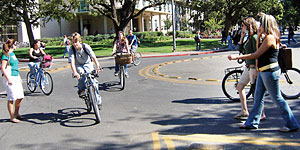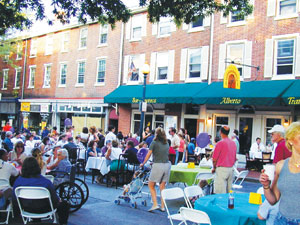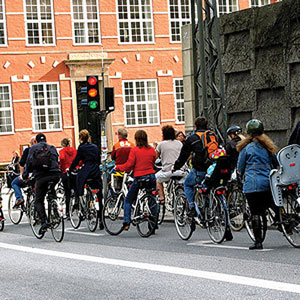
10 Cities with "Street Environments" Worth Striving for
DAVIS, CALIFORNIA (65,000)

This city’s logo is a bike, and they’ve certainly earned it. With bikes outnumbering motor vehicles, and 17 percent of commuters pedaling, cyclists make use of the city’s 100 miles of designated bike lanes and bike paths. To help navigate this intricate network, Davis offers a multi-colored bike map – free for all and available at local bike shops and the university (whose campus prohibits most car traffic). And a few years back the city decided to get rid of school buses because there was little need.
METUCHEN, NEW JERSEY (13,213)
Posited as a “walking town,” Metuchen earned its title by paying attention to both pedestrian safety and pedestrian attraction. On Main Street, two opposing lanes of traffic have parallel parking, so sidewalk users are shielded somewhat from the actual street. People who travel on foot are inspired to do so because of the array of good-looking “community-oriented” stores. It’s been said that residents get to know the store owners. And it’s because of this human-scale environment and ease of interaction, complete with traditional streetlights, good ole’ trees, and benches.
WEST CHESTER, PENNSYLVANIA (17,861)

Think about the power of the foot-errand. In West Chester, they’re possible, since all of the houses are within a comfortable walking distance of the town’s center. And people want to walk and shop and run errands in this “diversified, compact community” because it’s a hub of sociability and visual interest. William H. Whyte, an authority on the relationship between people and spaces, says, “Out by the interchanges there are drive-in banks. West Chester has walk-in banks. You walk right in off the street. You don’t need a car to gain admittance.”
PALO ALTO, CALIFORNIA (58,598)
Palo Alto has been moving toward innovative street projects for the past 30 years. They are host to the nation’s first bicycle boulevard – basically a shared roadway that serves as a main bicycle thoroughfare and is virtually stop free. The city has also been building bicycle bridges to adjacent communities and has installed bike-sensitive detectors at traffic signals. All these things may seem luxurious, but consider the fact that the Palo Alto Caltrain station now includes free, valet parking, servicing, and amenities.
CORVALLIS, OREGON (49,332)
In Corvallis, the numbers are hard to ignore. Ninety-seven percent of the city’s collector and arterial roadways contain those all-important bike lanes. One of the highest percentages of people in the nation commute regularly by bicycle (22 percent). Better yet, bikers don’t have to wrangle their bike into a tree to lock it up. All new businesses, apartment buildings, schools, and offices are required to install at least as many bike racks as there are parking spaces for cars. It has even been mandated that 50 percent of bike parking stalls must be covered. You’ve gotta work to get a rusty bike in Corvallis.
OTTAWA, CANADA (812,129)
When you think of Ottawa’s attitude toward transportation, think “diversified.” Consider the fact that Ottawa has established walking clubs, inline skating festivals, bike days, a sophisticated transit system, bus routes, and – from December to February – a handy ice skating canal. The bike days are perhaps the most impressive example of dedication toward car-free travel, occurring every Sunday in the summertime. The city shuts down large portions of roads to motor traffic, allowing all manner of other-wheeled recreation to take over.
PORTLAND, OREGON (582,130)
Portland’s bike-commuter stats rival all other big-city American claims to bike fame. With 260 miles of road available for cycling, you can see why 10 percent of work-goers bike. It’s also quite cycling “community,” with friendly competitions, clubs, and camaraderie abounding. Each year, a Bicycle Commute Challenge is held in which thousands of Portlanders compete for prizes. Interestingly, a commuter aerial cableway connects isolated districts as well, for serious commuting. A car-sharing program is available to residents who don’t pedal.
COPENHAGEN, DENMARK (1.168 million)

It’s a matter of municipal policy in Copenhagen that the number of biking/walking commuters rise to 40 percent by 2012, and 50 percent by 2015. The city is already nearing those numbers with an impressive 37 percent of the commuting pack being made up of pedalers. This city of Danes is so iconic and inspirational to bike-hungry cities that the term “Copenhagenize” has appeared in the international lexicon. In order to more fully Copenhagenize, a city would have to stash bicycles periodically downtown, rideable for a returnable deposit of 20 kroner.
OBERLIN, OHIO (8,195)
What’s old is new again: Main Street, the town square, and the bandstand. Oberlin has all three. The 13-acre Tappan Square, built as a gathering space for Oberlin College students, now contains the pulse of the city. It’s got brick walkways for strolling and tricycling and working out, and is a favorite spot to practice instruments and give informal concerts. Main Street itself contains amenities such as Gibson’s – a century-old ice-cream parlor/bakery/candy emporium. Oberlin has had to fight to keep its diagonal parking on both sides of the street, facing opposition from transportation agencies who claim traffic needs to be moved more “safely.” Residents find this to be backwards; they prefer to keep their pedestrians moving safely and their traffic moving slowly.
BOULDER, COLORADO (94,268)

Boulder makes it seem easy. Just devote 15 percent of your transportation budget to enhance bike travel, and it will happen. Disseminate color-coded maps, and greatness will happen. The city’s multi-use paths are plowed at the same time as regular streets, by separate snow removal crews. Bikers can visit GOBikeBoulder.net before their trip and work out a route on the 380-mile network of bike facilities. Afterward, they can record their miles, calories burned, and even find out how much CO2 and gas was sequestered by not driving.
WHAT TO TAKE AWAY FROM GREAT PLACES:
|
|
“We once routinely built such places. Now they are viewed as unique, or even exotic. However, many of their qualities can be incorporated into communities everywhere to create places people are proud to call home.” |
| Radical Idea: No Park « PREV | NEXT » Pedestrian Mall Madness |


















